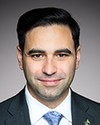Alistair came to you after you had suspended the meeting and asked, “When are you suspending to?” You have to remember that everybody had left the meeting. I don't know where all the Conservatives were, but I was sitting here and I heard the discussion.
That didn't take place on the record, so as far as I'm concerned, Mr. Chairman, the issue of the suspension was made, and it would be assumed—and there are other precedents that say that, which I will refer to—that it should proceed to the next meeting.
Let's say that your understanding is correct that you continued the meeting. The meeting was never called. The meeting was never recalled. As we showed here, only half the committee was here. You never called on the record for this meeting to continue at that time. It was not on the record.
However, let's say you did. The same book you referred to, on pages 402 and 403 says:
should the House adjourn for lack of quorum, any Order of the Day under consideration at the time, with the exception of non-votable items of Private Members' Business, retains its precedence on the Order Paper for the next sitting. The lack of quorum means only that the House adjourns for the day.
There's another quote, on page 401, that talks about what the process is when members are not present in the House:
If fewer than 20 members are present, the Speaker may adjourn the House until the next sitting day. The Speaker may take such an initiative only until the moment when the House is called to order; once the sitting has begun, "control over the competence of the House is transferred from the Speaker to the House itself...the Speaker has no right to close a sitting at his own discretion”.
That applies to you, sir. You have no right to do what you're doing now, because suspending the meeting means that it continues on at this meeting.
Of course, Standing Order 116 says:
In a standing, special or legislative committee, the Standing Orders shall apply so far as may be applicable, except the Standing Orders as to the election of a Speaker, seconding of motions, limiting the number of times of speaking and the length of speeches.
As I said, Mr. Chairman, the meeting on Monday, February 25 was not adjourned. It was only suspended. The chair—you, sir—suspended the meeting for votes. The meeting did not resume because it was never called. You never indicated on the record when it was to continue again.
Also in this book, on page 1098, it says:
Committees frequently suspend their meetings for various reasons, with the intention to resume later in the day. Suspensions may last a few seconds, several hours, or span even more than one day, depending on the circumstances, and a meeting may be suspended more than once. The committee Chair must clearly announce the suspension, so that recording ceases until the meeting resumes. Meetings are suspended, for example, to change from public to in camera mode, or the reverse; to enable witnesses to be seated or to hear witnesses by video conference; to put an end to disorder; to resolve a problem within the simultaneous interpretation system [and so forth].
You recalled a meeting that I was chairing back in 2010, and I recall that well.






